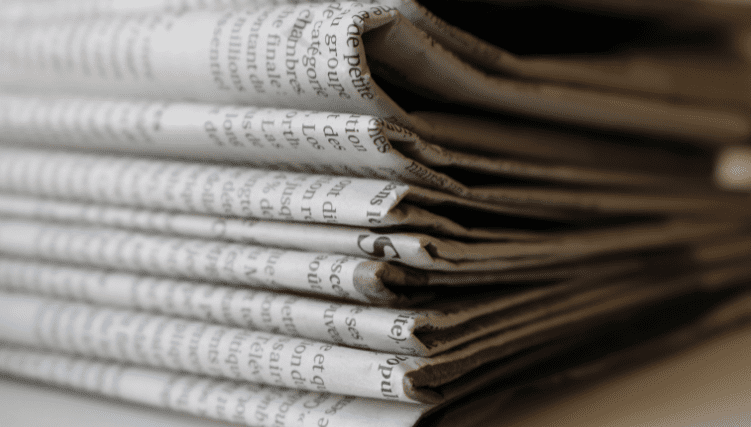Looking at some exemplars might help us envision what a healthy interplay between media and community can look like. While there are many people I could highlight as models of faithful belonging and redemptive publishing, it would be hard to top Frederick Douglass and Dorothy Day. For both of them, reading books and newspapers transformed their lives, introducing them to new communities of discourse and action.
Their reading led them to imagine new possibilities for joining with and working among the members of their own places. This membership, in turn, led them to speak publicly on behalf of their communities, challenging others to belong redemptively to their own neighbors and to address the pressing issues of their time.
In his autobiography, Douglass describes the arduous process by which he learned to read, first through the good graces of a naive slave mistress, and then by giving poor white boys bread in exchange for lessons. At the age of 12, he read “The Columbian Orator,” a classroom anthology of speeches and poems that includes an imagined dialogue between a master and his slave.
The slave made such good arguments for his emancipation that the master granted his manumission. Douglass was, of course, drawn to these arguments: “They gave tongue to interesting thoughts of my own soul, which had frequently flashed through my mind, and died away for want of utterance.” As Douglass goes on to explain, he didn’t even know the meaning of the word abolition—much less that there was a whole community of abolitionists agitating for the end of slavery—until he read a newspaper account of abolitionist activities.
After his reading brought the abolition community to his consciousness and helped him articulate a case for emancipation, Douglass devoted his energies to educating his enslaved friends. Once he had “created in them a strong desire to learn how to read,” he held a Sabbath school and taught any enslaved people who were interested. Their school was eventually discovered and broken up by white masters; these men knew the grave danger that reading posed to the institution of slavery.
As Douglass testifies, this learning community provided a rare opportunity for these downtrodden people to behave like “intellectual, moral, and accountable beings.” Eventually, Douglass escaped to the North, but instead of feeling free, he felt terribly lonely and vulnerable.He was particularly grateful for the aid of other free Black persons and abolitionists who helped him find a home in New Bedford.
This community, and the support it provided for its vulnerable members, motivated Douglass to take a more active role in sustaining it. He describes an incident where a free Black person had a dispute with a fugitive and threatened to betray him; the entire community came together to send the traitor away and protect the fugitive. It is this camaraderie and solidarity that inspired Douglass to move into the public sphere and advocate for the abolition of slavery and the empowerment of free African Americans.
He tells of his joy when he was able to pay for a subscription to the Liberator, William Lloyd Garrison’s abolitionist paper. This paper, Douglass attests, “became my meat and my drink. My soul was set all on fire.” And it soon gave him an “idea of the principles, measures and spirit of the anti-slavery reform.” At the urging of others, he began to speak at churches and abolitionist meetings, and his eloquence and testimony soon made him a popular speaker.
Douglass eventually separated himself from Garrison’s paper and speaking circuit and founded his own newspaper, the North Star. In the opening editorial, he situates the paper as a communal endeavor, arguing that the Black community “must be our own representatives and advocates, not exclusively, but peculiarly— not distinct from, but in connection with our white friends.” Thus it will not be committed to an ideology but to a community, which he names as “our long oppressed and plundered fellow countrymen”:
“We shall cordially approve every measure and effort calculated to advance your sacred cause, and strenuously oppose any which in our opinion may tend to retard its progress.” Rather than being narrowly antislavery, it will also discuss issues such as “temperance, peace, capital punishment, education. . . . While advocating your rights, the North Star will strive to throw light on your duties. [W]hile it will not fail to make known your virtues, it will not shun to discover your faults. To be faithful to our foes it must be faithful to ourselves, in all things.”
This language of rights and duties is common in republican discourse, but it emphasizes that Douglass was committed not just to an ideology or an interest group but to the formation of a healthy community.
Though he disagreed with Garrison about the best political strategy to achieve abolition, Douglass shared Garrison’s religious convictions. One version of the Liberator’s masthead depicts Christ in his role as liberator, proclaiming, “I come to break the bonds of the oppressor.”
Similarly, the motto of Douglass’s North Star declares, “Right is of no sex—Truth is of no color—God is the Father of us all, and all we are brethren.” If Douglass belonged to his fellow oppressed countrymen (and women—he was an early supporter of the suffrage movement), he belonged equally to the biblical prophetic tradition.
As his biographer David Blight puts it, “Douglass not only used the Hebrew prophets; he joined them.” Douglass consistently “rooted his own story and especially the story of African Americans in the oldest and most powerful stories of the Hebrew prophets.”Douglass’s political and social advocacy is unintelligible without a theological understanding of the fatherhood of God and the brotherhood of all people.
Ultimately, Douglass strove to build a community keyed to the gospel rather than to political trends. He failed at times, getting drawn into heated and sometimes petty political disputes and caring more about wielding political power than about standing as a faithful witness, but the very existence of his papers helped people imagine a community of Christians committed to living out the gospel’s valuation of each person— regardless of their race—as a child of God.
Papers like the North Star can help us see those neighbors whom we might otherwise overlook; they can help us imagine ourselves as members of a community that cares about the plight of the enslaved and others who are oppressed and that takes action to participate in God’s ongoing redemptive work.
Taken from “Reading the Times: A Literary and Theological Inquiry into the News” (InterVarsity Press, 2021) by Jeffrey Bilbro. Used with permission.
Do Good:
- Read “Reading the Times: A Literary and Theological Inquiry into the News” (InterVarsity Press, 2021) by Jeffrey Bilbro.
- See how you can get involved in the Fight for Good with The Salvation Army.











